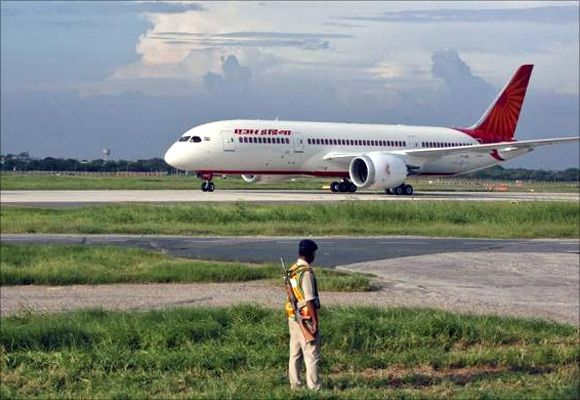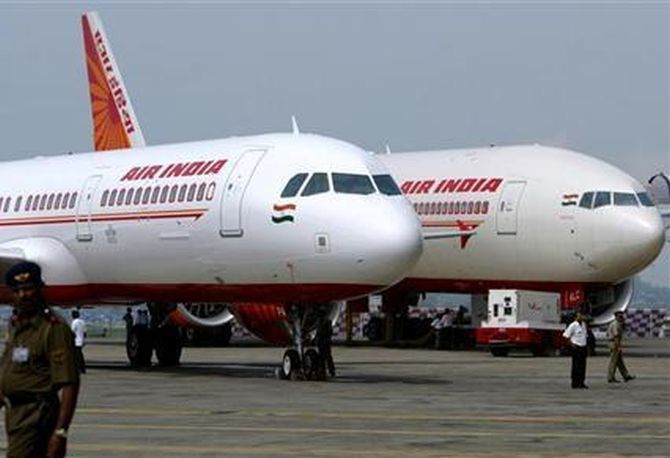There were many who had reposed faith in the Narendra Modi government for expeditious action but are today beginning to feel disillusioned, notes Jitender Bhargava.

Air India continues to hold relevance for two prime factors. One, it's historical past.
Second, because we now pay for its survival and are thus interested in knowing for how long are we expected to bear the burden.
Judging from the lack of any definitive action on part of successive governments, one can perhaps conclude that our paying for its survival isn't going to end anytime soon.
What has made the scenario ironic, if not tragic, is that whilst everyone associated with the airline know about Air India's critical situation, the prime stakeholders - the government, management and employees - appear to be in no hurry to take corrective measures in their respective domains.
They are perhaps under an illusion that inaction is the best action and that passage of time will throw up a solution regarding the airline's future.
The ostrich-like approach exists in spite of Air India giving alarming reminders on an almost weekly basis through media reports of delayed flights, technical problems associated with its Dreamliner aircraft, vendors raking up issues of pending payments or the employees unions raising their own perceived demands.

Photograph: Reuters
Problems galore, but scarce action!
So much so that even the Supreme Court, while hearing a clutch of petitions filed by unions, recently reminded Air India that its image has hit rock bottom and that the cash-strapped national carrier should pull up its socks and turn things around, else it could completely lose out to private airlines and even become non-existent.
There were many who had reposed faith in the Narendra Modi government for expeditious action but are today beginning to feel disillusioned.
Admittedly, six months isn't a long period, but it isn't also a short time for a government to devise at least the broad contours of a revival plan.
What the government possibly has for display thus far is a passing reference in the draft aviation policy that "an expert committee will be constituted to develop a future roadmap for Air India".
Those familiar with Air India know for sure that the airline has been in a "turnaround mode" for at least two decades, with several government-appointed committees having given recommendations with no discernible improvement in sight. Many would have been amused at the reference to yet another "expert committee", if only the situation had not been so grim.

While all-round criticism that the draft aviation policy has received from the industry and analysts alike may not have made the government realise the paucity of aviation expertise available in-house, it is time a blunt message is delivered.
The politicians and bureaucrats have thus far failed not just Air India but the entire Indian aviation industry.
The current financial state of most aviation companies due to high operational costs and growing marginalisation on international sectors at the hands of foreign carriers, recklessly bestowed with grant of seats far in excess of bilateral requirements, has left domestic players vulnerable.
Though many decisions can be attributed to crony capitalism for favouring particular airlines or countries, a host of decisions, including the infamous and controversial 5/20 rule (five years of domestic operations and a fleet of a minimum of 20 aircraft for international operations), have caused more harm than good to the industry.
As a consequence, the operational environment continues to be one of high cost in a highly price sensitive market, where even a minor escalation in fares leads to a dip in growth.
The incumbent aviation minister, A Gajapati Raju, certainly does not appear to be oblivious to ground realities. In an interaction with a newspaper recently, he had averred: "AI is losing all around and we are running against time. If you keep it going, there are problems, if you close it, there are other problems. Air India is like a patient in an ICU on ventilator. If the ventilator is removed, will the patient die or survive is a question.

We are not closing down any option. There is a financial restructuring plan and a turnaround plan - the plans are plenty, and they are going into a tailspin. So the situation is definitely not good. In this situation, nobody (investors) will touch it with a barge pole."
What then is holding up action? Even though almost all successful instances of turnarounds in the aviation industry can be attributed to strong leadership provided to ailing carriers by their respective governments besides restructuring of finances, our government does not appear to be serious about leadership.
The current incumbent, Rohit Nandan, an IAS officer, has been on an extension, pending search for a suitable successor.
Can a leader with an uncertain tenure take tough decisions necessary to take the turnaround process forward? More importantly, should it take the government months to find an appropriate person to head Air India?
The government's dithering can thus not just be attributed to the lack of political determination, lackadaisical approach towards Air India, but also on the absence of requisite expertise available in India, particularly if the choice is restricted to IAS officers.
The writer is former executive director, Air India and author of ‘The Descent of Air India’.










